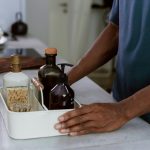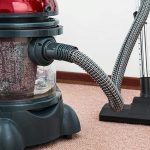Yes, you can use rubbing alcohol to disinfect your mousepad! It’s typically safe for fabric and plastic types, but check the manufacturer’s guidelines first. Just dampen a soft cloth with the alcohol and gently wipe the surface, paying attention to dirty spots. Make sure it’s moist, not soaking, and use a dry part of the cloth to remove excess moisture. Allow it to air dry completely. Discover more tips for keeping your workspace clean and your mousepad in top shape!
Table of Contents
Key Takeaways
- Rubbing alcohol is generally safe for disinfecting fabric and plastic mousepads, but always check manufacturer guidelines first.
- High-concentration alcohol may damage or discolor some surfaces, particularly rubber mousepads.
- Use a damp, not soaking wet, cloth with rubbing alcohol to gently clean the mousepad.
- Allow the mousepad to air dry completely after cleaning before using it again.
- Regular cleaning with rubbing alcohol can improve hygiene and prolong the lifespan of your mousepad.
Understanding Mousepad Materials
When you think about mousepads, you might picture a simple surface, but their materials can vary widely. Most mousepads fall into three main categories: fabric, plastic, and metal.
Fabric mousepads offer a soft, textured surface, providing excellent control for precision tasks. They’re often made from cloth and can absorb moisture, which is great for comfort but can be tricky for cleaning.
Plastic mousepads are smooth and durable, making them easy to wipe down, but they may not provide the best grip.
Metal mousepads are sturdier and can give you a sleek aesthetic, but they can feel cold and hard under your hand.
Understanding these materials helps you choose the right mousepad for your needs and informs how you’ll maintain it.
Benefits of Disinfecting Your Mousepad
Cleaning your mousepad regularly is just as important as choosing the right material. Disinfecting it not only maintains its quality but also enhances your overall computing experience.
Regularly cleaning your mousepad is essential for quality maintenance and an improved computing experience.
Here are three key benefits of keeping your mousepad clean:
- Improved Hygiene: A clean mousepad reduces the number of germs and bacteria, lowering your risk of illness, especially during flu season.
- Better Performance: Dust and debris can interfere with your mouse’s tracking ability. A disinfected surface guarantees smooth movement and accuracy.
- Longer Lifespan: Regular cleaning helps preserve the materials, preventing wear and tear. This way, you get more value from your investment.
Is Rubbing Alcohol Safe for Mousepads?
Is rubbing alcohol a safe choice for disinfecting your mousepad? Yes, but it depends on the material. Most fabric and plastic mousepads can handle rubbing alcohol, but you should always check the manufacturer’s recommendations first. Using high-concentration alcohol can lead to damage or discoloration, especially on certain surfaces.
Here’s a quick comparison of mousepad materials and their compatibility with rubbing alcohol:
| Material | Safe to Use Alcohol? | Notes |
|---|---|---|
| Fabric | Yes | Use sparingly |
| Plastic | Yes | Avoid high concentrations |
| Rubber | No | May deteriorate over time |
How to Properly Disinfect With Rubbing Alcohol
To properly disinfect your mousepad with rubbing alcohol, you’ll need to gather a few essential materials first.
Once you have everything ready, follow a simple step-by-step process to guarantee effective cleaning.
Let’s get started on making your mousepad germ-free!
Prepare Your Materials
Before diving into the disinfection process, gather a few essential materials to make sure you tackle your mousepad effectively.
Having everything ready will streamline the process and guarantee you achieve the best results. Here’s what you’ll need:
- Rubbing alcohol (at least 70% concentration) – This is vital for effectively killing germs and bacteria.
- Soft cloth or paper towels – Use these to apply the rubbing alcohol and wipe down your mousepad without causing damage.
- A small bowl or spray bottle – This will help you mix or apply the rubbing alcohol evenly across the surface.
With these materials in hand, you’re set to move forward with disinfecting your mousepad safely and efficiently.
Disinfection Process Steps
Start by dampening your soft cloth or paper towel with rubbing alcohol, ensuring it’s not soaking wet but just moist enough to effectively clean.
Next, gently wipe the surface of your mousepad in circular motions, focusing on any areas that seem particularly dirty or stained. Pay extra attention to corners and edges where grime tends to accumulate.
After you’ve thoroughly cleaned the surface, take a dry part of the cloth or a separate towel to wipe away any excess moisture.
Allow your mousepad to air dry completely before placing it back on your desk or using it again. This process not only disinfects but also extends the life of your mousepad.
Alternative Cleaning Solutions for Mousepads
While rubbing alcohol is a popular choice for disinfecting mousepads, there are several alternative cleaning solutions that can effectively maintain your mousepad’s hygiene and performance.
Rubbing alcohol is great for disinfecting mousepads, but there are several effective alternatives to keep them clean and performing well.
Here are three options to explore:
- Soap and Water: Mix mild dish soap with warm water. Use a soft cloth to gently scrub your mousepad, then rinse with a damp cloth and let it air dry.
- White Vinegar: Combine equal parts white vinegar and water in a spray bottle. Lightly mist your mousepad, wipe it down with a cloth, and let it dry completely.
- Baby Wipes: For quick cleaning, use non-alcoholic baby wipes. They’re gentle and efficient for removing dirt and bacteria without damaging your mousepad.
These alternatives can keep your mousepad clean and functioning well!
Frequency of Mousepad Cleaning
Regularly cleaning your mousepad is essential for maintaining its performance and hygiene. Depending on your usage, aim to clean it every two to four weeks.
If you notice dirt or grime buildup or if you eat or drink near your workspace, you might want to clean it more often. Dust, oils, and bacteria can accumulate quickly, affecting how your mouse glides and operates.
If you’re a gamer or someone who spends long hours on the computer, consider cleaning it weekly for peak performance.
Don’t forget to inspect it regularly; any visible stains or odors are signs that it’s time for a thorough scrub.
Keeping your mousepad clean not only enhances its lifespan but also contributes to a healthier workspace.
Signs Your Mousepad Needs Replacement
Knowing when to replace your mousepad can save you from frustration and enhance your overall computing experience.
Here are some signs that it’s time to get a new one:
- Worn-out Surface: If your mousepad shows visible wear or frays at the edges, it can affect your mouse’s tracking ability.
- Stains and Odors: Persistent stains or unpleasant smells that don’t come out with cleaning can make your workspace unpleasant.
- Slipping or Sliding: If the mousepad slides around on your desk or doesn’t grip well, it can disrupt your workflow and make it harder to use your mouse effectively.
Tips for Maintaining a Clean Workspace
To keep your workspace tidy, it’s essential to establish a regular cleaning schedule.
You should also use proper cleaning techniques to guarantee every surface, including your mousepad, stays germ-free.
Regular Cleaning Schedule
While it might seem easy to overlook cleaning your mousepad, establishing a regular cleaning schedule is essential for maintaining a hygienic workspace. A dirty mousepad can harbor germs and dust, impacting both your health and productivity.
Here are three tips to help you stay on track:
- Weekly Check: Make it a habit to inspect your mousepad every week. If you notice any stains or grime, plan to clean it.
- Set Reminders: Use your phone or calendar to set reminders for cleaning your mousepad. Consistency is key.
- Combine Tasks: Tie mousepad cleaning to another regular activity, like wiping down your keyboard or desk, to streamline your cleaning routine.
Proper Cleaning Techniques
When it comes to keeping your mousepad clean, using the right techniques makes all the difference.
Start by unplugging or disconnecting your mouse and mousepad. For fabric mousepads, mix a solution of warm water and mild detergent. Use a soft cloth to gently scrub the surface, paying extra attention to stained areas. Rinse with clean water and let it air dry completely.
If you have a hard mousepad, wiping it down with rubbing alcohol on a microfiber cloth is effective. This not only disinfects but also removes oils and grime.
Remember to clean your mousepad regularly and avoid eating or drinking near your workspace to maintain a cleaner environment. Your mousepad will thank you for it!
Frequently Asked Questions
Can Rubbing Alcohol Remove Stubborn Stains From My Mousepad?
So, you think rubbing alcohol’s a magical potion for stains? Well, it can help! Just dab it on, scrub gently, and rinse. But don’t expect it to fix all your life’s messes!
How Long Does Rubbing Alcohol Take to Disinfect a Mousepad?
Rubbing alcohol typically takes about 10 minutes to effectively disinfect your mousepad. Make sure you cover the surface evenly, allowing it to air dry completely afterward to maximize its germ-fighting capabilities and maintain the material’s integrity.
Will Rubbing Alcohol Affect the Mousepad’s Texture or Grip?
Rubbing alcohol can potentially alter your mousepad’s texture or grip, especially if it’s made of fabric or rubber. It’s best to test a small area first to see how it reacts before proceeding.
Can I Use Scented Rubbing Alcohol for Cleaning My Mousepad?
You can use scented rubbing alcohol, but be cautious. The fragrance might leave a residue or affect the texture. It’s better to stick with unscented options for a thorough clean without compromising your mousepad’s performance.
Is It Necessary to Rinse the Mousepad After Using Rubbing Alcohol?
You might think rinsing isn’t needed, but it’s best to rinse your mousepad after using rubbing alcohol. This guarantees no residue remains, keeping your surface clean and preventing any potential damage to your equipment.




